Developing Age-Friendly Cities: The Challenges of Local Governance in the 21ST Century
Keywords:
Older resident, Age-friendly cities, Local governanceAbstract
The concept of age-friendly cities is gaining momentum in the 21st century as it is predicted that the global population of individuals and older residents will increase doubling in size by 2050 (United Nations Development Programme, 2023). However, the development of these cities is faced with various obstacles in local governance, including limited funding, resistance to change, inadequate data and research, limited participation and engagement from older adults, and lack of inter-generational cooperation. In order to create inclusive and supportive communities for older adults, local governments must overcome these challenges by prioritizing funding, engaging older adults, conducting research, and fostering inter-generational cooperation. This article highlights the challenges of developing age-friendly cities in the 21st century and the importance of addressing them for the well-being of older residents.
References
Bradley, D. E., & Longino, C. F. (2001). How Older People Think About Images of Aging in Advertising and the Media. Generations: Journal of the American Society on Aging, 25(3), 17-21.
Kokpol, Orathai. (2016). Urbanization: When “city” Becomes a Problem of Local Management Modern. Bangkok: King Prajadhipok’s Institute. [In Thai]
Ladbuakhao, S. (2020). Local Finance: Problems and Solutions. Political Science and Public Administration Journal, 11(1), 189-214.
Madrid, I. I. (2002). Thailand Implementation of the Madrid International plan of action on ageing (MIPAA) 2002-2016. New York: United Nations, 2417.
Ministry of Social Development and Human Security and the Ministry of Public Health. (2021). The Plan of Action for Long-term Elderly Care, 2021.
OECD. (2015). Ageing in Cities. OECD. Retrieved February 24, 2023, from http://dx.doi.org/10.1787/9789264231160-en.
Phrompayak, D. and Wanchai, A. (2019). A Systematic Review of Factors Influencing Social Participation of Older Adults. Pacific Rim International Journal of Nursing Research, 23(2), 131–141.
Reese C. Wilson (1976). Urban priority 1: Increased local government effectiveness – JSTOR.ORG. (n.d.). Retrieved February 20, 2023, from https://www.jstor.org/stable/pdf/3379955.pdf
Ruangkiatkul, N. (2022). Factors Associated with Health Literacy among Thai older adults. Journal of the Department of Medical Services, 47(1), 80-86.
Sumalee, E. and Tanchai, C. (2019). Smart city Smart city: basic concepts and operating systems for digital cities. King Prajadhipok's Institute First printing. [In Thai]
Steels, S. (2015). Key characteristics of age-friendly cities and communities: a review. Cities. ISSN 0264-2751.https://doi.org/10.1016/j.cities.2015.02.004
Thang, L. L. (2011). Family policy: Promoting intergenerational understanding between the young and old: the case of Singapore. Retrieved February 26, 2023, from https://www.un.org/esa/socdev/family/docs/egm11/Bogenschneider-paper.pdf
The Cross National Data Center in Luxembourg. (2018). Luxembourg Income Study Database (LIS) and the Luxembourg Wealth Study Database (LWS). LIS cross-national data center in Luxembourg. Retrieved February 28, 2023, from https://www.lisdatacenter.org/
United Nations. (2018). Ageing related policies and priorities in the implementation of the 2030 Agenda for Sustainable Development. Retrieved February 26, 2023, from https://www.un.org/development/desa/ageing/wp-content/uploads/sites/24/2019/07/Analysis-Ageing_VNRs_Final28122018.pdf
United Nations. (2020). 68% of the world population proected to live in urban areas by 2050, UN Desa Department of Economic and Social Affairs. United Nations. Retrieved February 28, 2023, from https://www.un.org/development/desa/en/news/population/2018-revision-of-world-urbanization-prospects.html
United Nations. (2022). World Population Prospects 2022, Online Edition. Chapter one. New York: United Nations.
United Nations Development Programme. (2023). World Social Report 2023: Leaving No One Behind – Ageing World. Retrieved from https://desapublications.un.org/publications/world-social-report-2023-leaving-no-one-behind-ageing-world
U.S. Department of Health and Human Services. (2023). Aging in place: Growing older at home. National Institute on Aging. Retrieved February 21, 2023, from https://www.nia.nih.gov/health/aging-place-growing-older-home
Weerasak K. (2004) Local Government Initiatives in Thailand: Cases and Lessons Learned. Asia Pacific Journal of Public Administration, 26(2), 217-239,
World Economic Forum. (2022). Accelerating Urban Inclusion for a Just Recovery (Ser. Insight Report, pp. 19–21). Geneva, Switzerland: World Economic Forum.
World Economic Forum. (2022). Accelerating Urban Inclusion for a Just Recovery (Ser. Insight Report, pp. 22). Geneva, Switzerland: World Economic Forum.
World Health Organization. (2007). Global age-friendly cities: A guide. World Health Organization.
World Health Organization. (2016). Creating Age-friendly Environments in Europe: A Tool for Local Policy-makers and Planners. Retrieved February 23, 2023, from https://apps.who.int/iris/bitstream/handle/10665/334252/9789289052122-eng.pdf
World Health Organization. (2017). Integrated care for older people: guidelines on community-level interventions to manage declines in intrinsic capacity. Retrieved February 26, 2023, from https://www.who.int/publications/i/item/9789241550109
World Health Organization. (2018). The Global Network for Age-friendly Cities and Communities: Looking back over the last decade looking forward to the next. Retrieved February 24, 2023, from https://www.who.int/activities/creating-age-friendly-cities-and-communities
Downloads
Published
How to Cite
Issue
Section
License
Copyright (c) 2023 PAAT Journal

This work is licensed under a Creative Commons Attribution-NonCommercial-NoDerivatives 4.0 International License.


